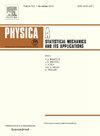Motif-based mix-order nonnegative matrix factorization for community detection
IF 2.8
3区 物理与天体物理
Q2 PHYSICS, MULTIDISCIPLINARY
Physica A: Statistical Mechanics and its Applications
Pub Date : 2025-01-20
DOI:10.1016/j.physa.2025.130350
引用次数: 0
Abstract
Community structure is one of the important characteristics of complex networks, so it is of great application value to correctly detect community structure in the study of network structure. Nonnegative matrix factorization (NMF) has been proved to be an ideal model of the community detection. Traditional NMF only focuses on the first-order structure (such as adjacency matrix), but does not consider the higher-order structure (such as motif adjacency matrix). However, only considering one of them cannot well represent the global structural characteristics of complex networks. In this paper, we propose a new Mixed-Order Nonnegative Matrix Factorization (MONMF) framework, which can model both first-order and higher-order structures. Previous nonnegative matrix factorization is mostly used in undirected networks, but we will study based on a variety of motif types in directed networks, use motifs to capture higher-order structures in networks, and introduce linear and nonlinear methods to combine the adjacency matrix representing the first-order structure with the motif adjacency matrix representing the higher-order structure to construct a new feature matrix of NMF. At the same time, we introduce the missing edge matrix that characterizes the edgeless connection structure of the network, and gives the expression of the motif adjacency matrix of the three-node open simple motif and the three-node open anchor motif. The MONMF operation is mainly performed on different real networks for open simple motifs and open anchor motifs. Compared with the comparison methods, MONMF can significantly improve the performance of community detection in complex networks.
求助全文
约1分钟内获得全文
求助全文
来源期刊
CiteScore
7.20
自引率
9.10%
发文量
852
审稿时长
6.6 months
期刊介绍:
Physica A: Statistical Mechanics and its Applications
Recognized by the European Physical Society
Physica A publishes research in the field of statistical mechanics and its applications.
Statistical mechanics sets out to explain the behaviour of macroscopic systems by studying the statistical properties of their microscopic constituents.
Applications of the techniques of statistical mechanics are widespread, and include: applications to physical systems such as solids, liquids and gases; applications to chemical and biological systems (colloids, interfaces, complex fluids, polymers and biopolymers, cell physics); and other interdisciplinary applications to for instance biological, economical and sociological systems.

 求助内容:
求助内容: 应助结果提醒方式:
应助结果提醒方式:


